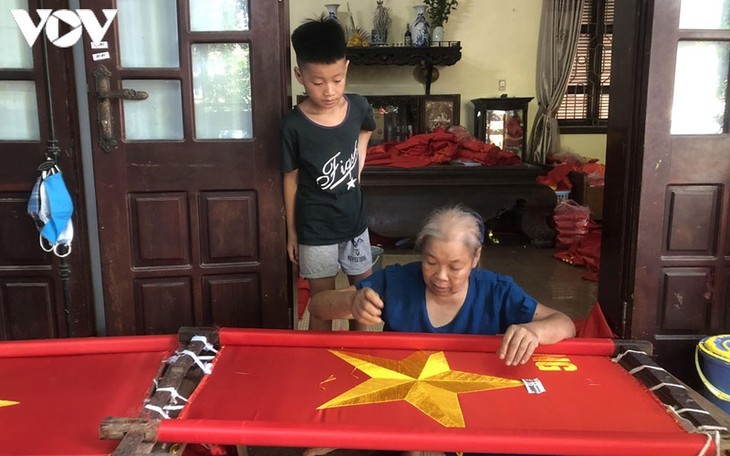(VOVWORLD) - Whenever Vietnam celebrates its National Day on September 2nd, the tailors of Tu Van village in Hanoi’s Thuong Tin district get busy filling orders for national flags. Each flag, made by hand or machine, is filled with the tailor’s soul.

A family of three generations in Tu Van village are engaged in weaving the flags.
|
September is the busiest month for Tu Van villagers. Vuong Thi Nhung, whose family has been making national flags for three generations, said every step, from cutting the fabric to printing or embroidering or sewing the yellow stars, is done in their small house.
70-year-old Le Thi Tinh told VOV, while completing the final embroidery stitches on a flag ordered for the national holiday, that her craft is only for someone who is patient and meticulous.
Tinh insisted that the most difficult step is to infuse a life into each product, whether big or small, printed or embroidered.
“We love and want to pursue the trade until we are old and can’t do it anymore. Currently only old people like us still follow the craft. Young villagers prefer working for a company. But we strongly believe that they will come back to the craft when they grow old. Flag making will never die,” said Tinh.
Tu Van has been famous for embroidery and weaving since the 16th century, when many of the villagers opened shops in downtown Hanoi to sell their products.
When the general uprising of August, 1945, took place, tens of thousands of red flags made in Tu Van flew over the streets of Hanoi, and Tu Van has been supplying national flags ever since.
Dang Hong Hieu, a local flag maker, said that his family and Nhung’s are the only households in Tu Van that still make flags manually.
“My wife and I don’t want to do any other job. When we see our products on TV or in a parade, we feel very proud,” said Hieu.
 September is the busiest month for Tu Van flag makers. September is the busiest month for Tu Van flag makers. |
The village’s reputation has grown as the demand for national flags has increased. When the national football team won the ASEAN Football Federation championship in 2018 and the men’s team won gold medal at the Southeast Asian Games in 2019, Nhung’s family had to hire dozens of additional workers to satisfy the demand for flags.
“Sometimes it’s very hard. For major festivals, holidays and sports victories, we have to work day and night to meet the renewed public demand for banners, posters and national flags. It makes us happy to serve people nationwide. Now our production has been modernized so we have it a bit easier,” said Hieu.
Families in Tu Van let their children get acquainted with the trade when they are little, hoping to make them proud of it in hopes of handing it down to the next generation.
15-year-old Pham Thu Trang said, while learning how to embroider a flag, “It doesn’t take much time to embroider a flag with an embroidery machine. But it takes 2 to 3 days to embroider a flag by hand. Machine-made products are available anywhere, but my family is among the few households in the village that embroider flags manually. I’m proud of that and want to maintain our traditional craft.”